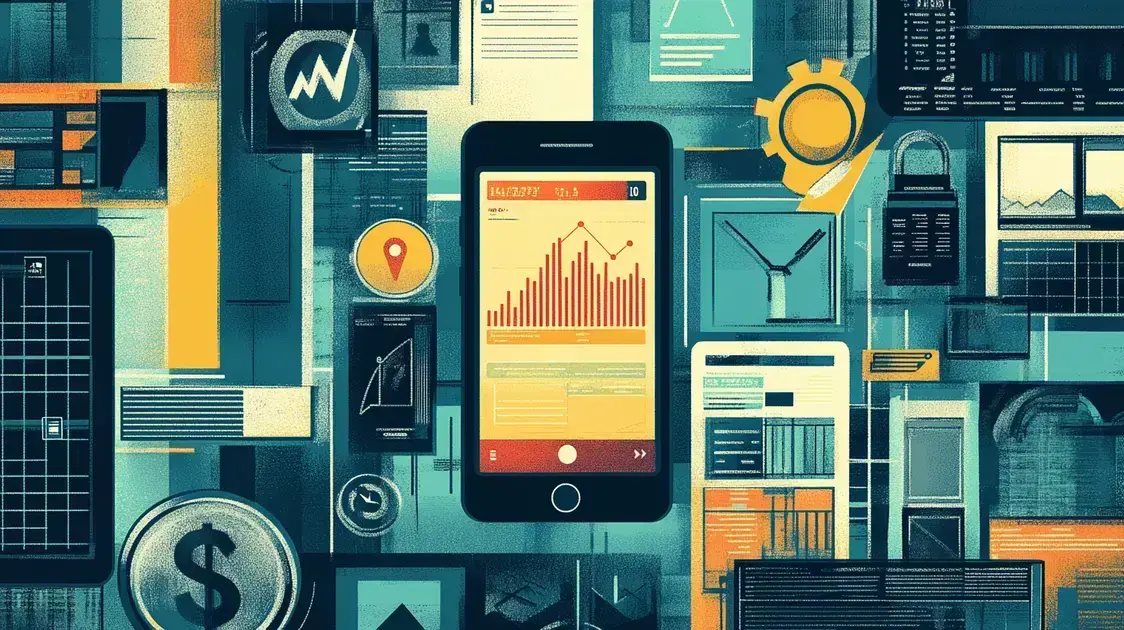In today’s fast-paced world, managing money wisely is more important than ever. Personal Finance Apps offer practical solutions to simplify budgeting, track spending, and plan for future expenses. With the right app, you can gain better control over your finances and make informed financial decisions.
These apps provide features like expense categorisation, bill reminders, and savings trackers, helping users stay on top of their financial health. Many also offer real-time insights, allowing you to adjust your spending habits and work toward long-term financial stability. The convenience of having all your financial data in one place makes managing money easier and more efficient.
With so many options available, choosing the right app can be challenging. Understanding their features and benefits is key to finding the best fit for your needs. Keep reading to discover the top Personal Finance Apps that can help you take control of your financial future.
Overview of Personal Finance Management Apps
Managing personal finances has become easier thanks to various **personal finance management apps**. These apps provide users with the ability to track expenses, set budgets, and save money effectively. In recent years, the growing number of options available has transformed how individuals approach their financial planning.
What are Personal Finance Management Apps?
Personal finance management apps are digital tools designed to help users manage their financial activities in an organized manner. They allow you to monitor your spending, create budgets, and generate reports to visualize your financial health. By connecting to bank accounts and credit cards, these apps can automatically track transactions in real-time, making it simpler to keep an accurate record of your finances.
Why Use Personal Finance Apps?
There are many reasons why using a personal finance app can be beneficial. It can help you identify spending habits, highlight areas where you can save, and provide a clear picture of your financial situation. For instance, setting a budget using an app can lead to more informed decisions and help you stick to your financial goals.
Types of Personal Finance Apps
Different types of personal finance management apps cater to a variety of needs. Some focus primarily on budgeting, enabling users to allocate funds across different categories. Others may include features like investment tracking, bill reminders, and savings goals. The diversity of options available makes it essential to choose the app that aligns best with your financial objectives.
Popular Personal Finance Apps
Among the most popular personal finance apps are Mint, YNAB (You Need A Budget), and PocketGuard. Each of these apps provides unique features that can help users manage their finances efficiently. For example, Mint allows for comprehensive budgeting and credit score tracking, while YNAB emphasizes proactive budgeting strategies.
In a world where financial literacy is increasingly crucial, embracing **personal finance management apps** can empower you to take control of your financial future. By selecting the right app, you can ensure that you stay on top of your spending and achieve your financial goals more effectively.
Top Features to Look For

When searching for the best apps for managing personal finances, there are several crucial features to consider. These features can significantly impact how effectively you can track and manage your finances.
1. User-Friendly Interface
A simple and intuitive layout is essential for any personal finance app. Users should be able to navigate easily without needing extensive tutorials. A well-designed interface can enhance user experience and encourage more frequent use.
2. Automatic Bank Syncing
Look for apps that offer automatic syncing with your bank accounts and credit cards. This feature allows for real-time transaction tracking, making it easier to keep tabs on your spending without manual input.
3. Budgeting Tools
Effective budgeting tools are a must-have in any personal finance app. These tools should allow you to set limits for various spending categories and notify you when you are nearing those limits. This helps promote financial discipline.
4. Expense Tracking
A solid expense tracking feature will help users categorise their spending habits. The app should provide insights into where your money goes, making it easier to identify potential areas for cuts.
5. Reporting and Analytics
The best apps offer robust reporting tools that allow you to generate financial summaries and reports. These reports can provide an overview of your spending patterns, savings goals, and overall financial health.
6. Security Features
Security is paramount when dealing with financial data. Ensure the app has strong encryption protocols and offers two-factor authentication. This protects your sensitive information from potential breaches.
By focusing on these key features, you can find the right personal finance management app that suits your needs and helps you achieve your financial goals.
Comparison of the Best Finance Apps
When looking for the best finance apps, it’s important to compare different options to find the one that meets your needs. Here is a comparison of some top personal finance management apps available today.
Mint
Mint is a popular finance app that offers strong budgeting tools and automatic syncing with bank accounts. Users can track expenses, set saving goals, and even check their credit scores for free. Its clean and user-friendly interface makes it easy to navigate.
YNAB (You Need A Budget)
YNAB is designed for proactive budgeting. It helps you allocate every dollar to a specific category, ensuring you live within your means. YNAB offers educational resources to improve financial literacy, which sets it apart from many other apps.
PocketGuard
PocketGuard makes it easy to see at a glance how much you have left to spend. It automatically categorizes your expenses and identifies recurring bills, giving you an accurate overview of your financial situation. This app is great for users who want simplicity and clarity.
GoodBudget
GoodBudget operates on a digital envelope budgeting system. Users can create envelopes for different spending categories and allocate funds accordingly. This app works well for users who prefer a cash-only budgeting approach and want to track their finances manually.
Personal Capital
Personal Capital combines budgeting and investment tracking in one app. It provides tools for retirement planning, allowing you to view all your financial accounts in one place. The app offers comprehensive reports to help analyse your spending and saving habits.
Clarity Money
Clarity Money uses AI to help manage your finances. It identifies subscriptions you may no longer need and assists in creating budgets based on your spending patterns. This app is particularly helpful for users who want a more automated approach to budgeting.
By comparing these finance apps, you can find the one that offers the features and tools you need to effectively manage your personal finances.
User Reviews and Ratings

User reviews and ratings play a vital role in selecting the best personal finance apps. They provide honest insights from real users about their experiences and satisfaction levels. Here’s a look at some popular finance apps based on user feedback.
Mint
Mint often receives high ratings for its comprehensive features. Users appreciate its ability to sync with multiple bank accounts and set budgets. However, some users report occasional syncing issues that can impact transaction accuracy.
YNAB (You Need A Budget)
YNAB enjoys rave reviews for its budgeting philosophy. Users love the educational content that teaches financial awareness. Some mention that the initial learning curve can be steep, but the results are worth it.
PocketGuard
PocketGuard is praised for its simple and clean design. Users enjoy its ability to show remaining spending money at a glance. However, a few users noted that it may lack some advanced budgeting features offered by other apps.
GoodBudget
GoodBudget receives positive feedback for its unique envelope budgeting style. Users appreciate that it fosters discipline in spending. Some mention that it requires manual entry, which may not suit everyone.
Personal Capital
Personal Capital is valued for its investment tracking features. Users report that it provides a comprehensive overview of their financial health. However, some feel it can be overwhelming due to its detailed reporting options.
Clarity Money
Clarity Money users appreciate its tracking of subscriptions and expenses. They find the AI features helpful for managing finances better. A few users expressed concern about data privacy, preferring more transparency about how their information is used.
Overall, looking at user reviews and ratings can help you determine which personal finance app aligns best with your financial management needs. This feedback guides you towards a choice that suits your unique financial situation.
Cost Analysis of Apps
Cost is a significant factor when choosing the best personal finance apps. Here’s a detailed analysis of the pricing models for some popular finance apps.
Mint
Mint is free to use, making it a popular choice among users. The app generates revenue through targeted advertisements and premium features. While its core features are excellent at no cost, some users may find the ads slightly intrusive.
YNAB (You Need A Budget)
YNAB operates on a subscription model. Users can opt for a monthly fee of around R130 or a discounted yearly plan. YNAB offers a free trial for the first 34 days, allowing users to experience its features before committing.
PocketGuard
PocketGuard offers a free version with limited features. To unlock more advanced tools, users can subscribe to the premium version for approximately R80 per month. The premium version includes features like custom categories and unlimited bank syncing.
GoodBudget
GoodBudget is free to use with basic features. Users can upgrade to a premium plan for around R50 per month, which allows access to more envelopes and account syncing. This flexibility makes it suitable for varying budgeting needs.
Personal Capital
Personal Capital is free for basic financial tools. However, they offer wealth management services that come with a fee based on the assets managed. This option is designed for users looking for more tailored investment advice.
Clarity Money
Clarity Money is also free to use. It has revenue-sharing agreements with banks, which allows users to access its features without direct costs. Users enjoy the benefits of subscription tracking and budgeting without paying out of pocket.
Understanding the cost structure of these personal finance apps helps you choose a suitable option that meets both your financial needs and budget.
Tips for Maximising Your Finance App Usage

To get the most out of your personal finance app, consider the following tips that can enhance your experience and help you achieve better financial control.
1. Set Clear Goals
Establish specific financial goals, such as saving for a vacation or paying off debt. Most finance apps allow you to set and track these goals, providing motivation along the way.
2. Regularly Update Your Transactions
Make it a habit to update your transactions daily or weekly. This will give you a clear picture of your spending habits and help you stay on top of your budget.
3. Utilize Budgeting Features
Take advantage of the budgeting tools available in the app. Set limits for various spending categories and receive alerts when you are close to exceeding those limits.
4. Review Analytics and Reports
Most apps provide reports and analytics on your spending. Review these insights regularly to identify patterns, areas for improvement, and to adjust your budget accordingly.
5. Explore Additional Features
Many finance apps offer features like bill reminders, investment tracking, and savings challenges. Explore these tools to maximise the efficiency of the app and manage your finances better.
6. Stay Informed
Keep an eye on updates and new features of your chosen app. Developers often add improvements and tools that can enhance your financial management experience.
By following these tips, you can fully leverage the capabilities of your personal finance app and make informed decisions about your financial well-being.
FAQ – Frequently Asked Questions about Personal Finance Apps
What are the best personal finance apps?
Some of the best personal finance apps include Mint, YNAB, PocketGuard, GoodBudget, and Personal Capital. Each app offers unique features to help you manage your finances.
Are personal finance apps free to use?
Many personal finance apps offer free versions with basic features, while others operate on a subscription model with premium capabilities available for a fee.
How do I choose the right finance app?
Consider your financial goals, the features you need, user reviews, and the cost of the app. It’s important to find an app that aligns with your specific financial management style.
Can I sync my bank accounts with these apps?
Yes, most personal finance apps allow you to sync your bank accounts and credit cards for automatic transaction tracking and expense management.
How can I maximise my personal finance app usage?
To maximise usage, set clear financial goals, regularly update transactions, utilise budgeting features, review reports, explore additional features, and stay informed with app updates.
Are personal finance apps secure?
Most reputable personal finance apps use strong encryption protocols and offer two-factor authentication, making them secure for managing sensitive financial information.
Check out our article on Fitness Apps to discover how these tools can help you track your progress and achieve your health goals.
